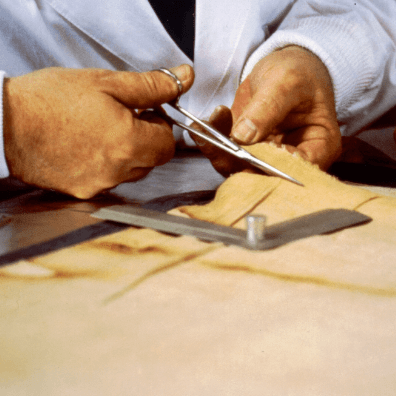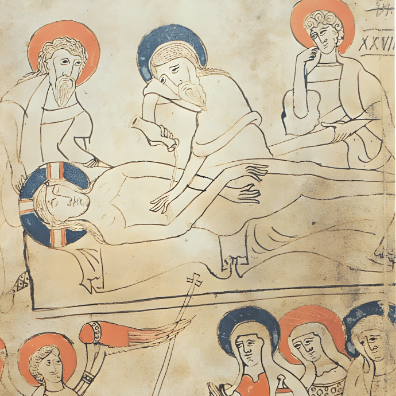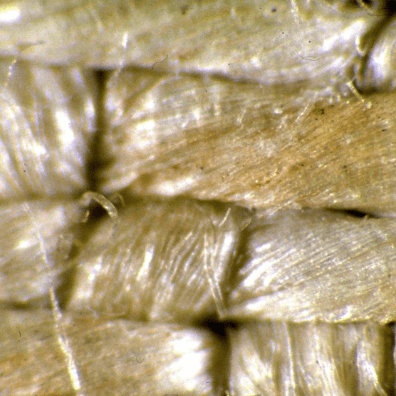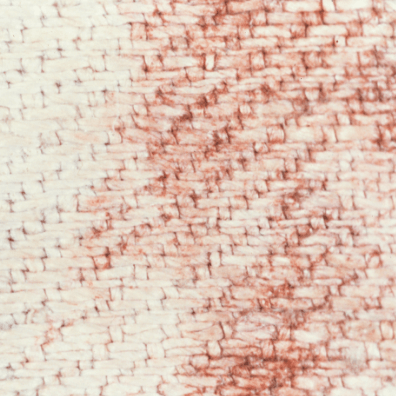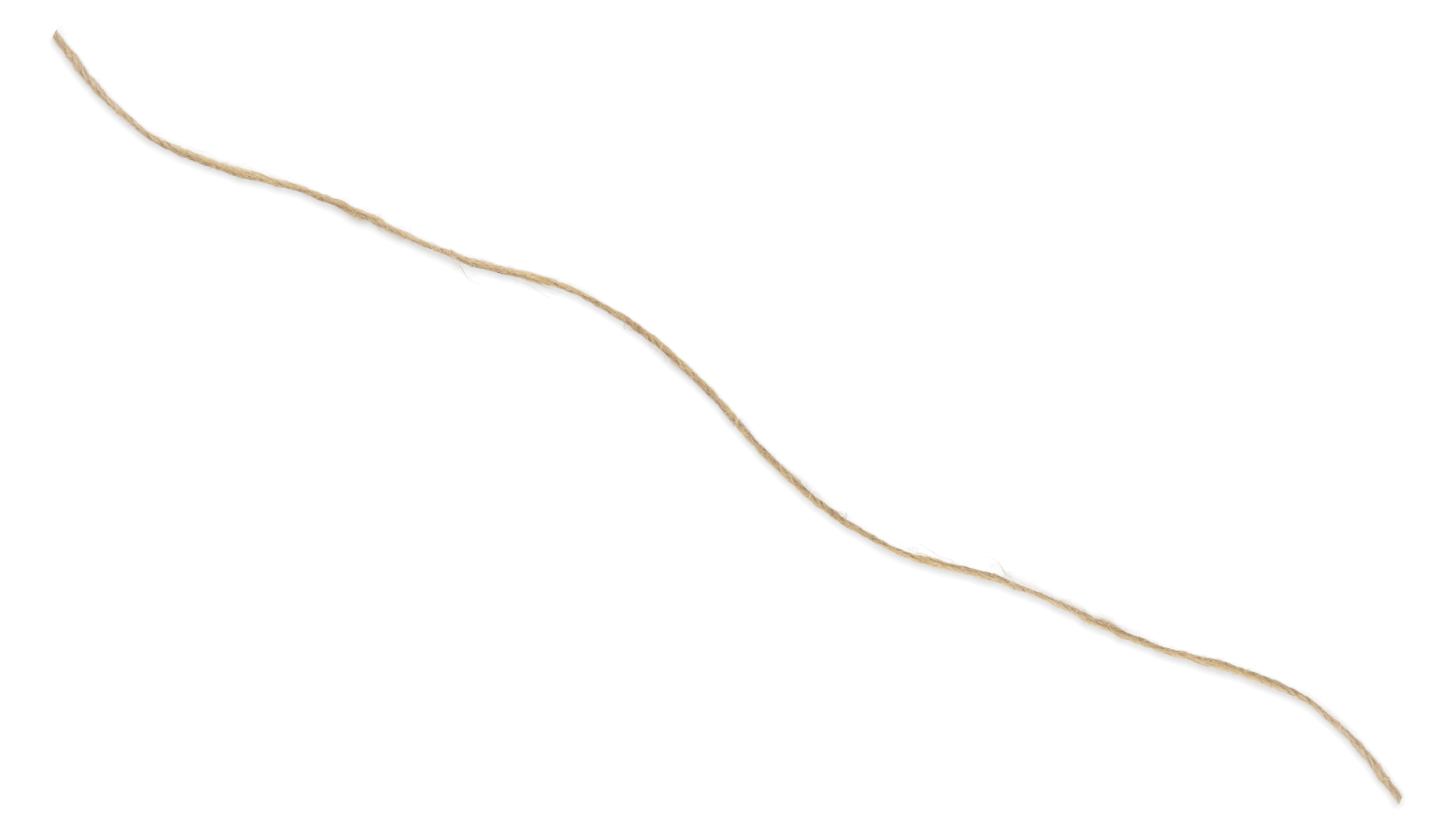HOME | THE SHROUD | SHROUD 101
SHROUD 101

WHAT IS THE SHROUD OF TURIN?
The Shroud of Turin is a linen cloth that shows the full body image of a naked man, front and back. Many people believe this cloth wrapped the dead body of Jesus of Nazareth.

WHAT DOES THE SHROUD OF TURIN LOOK LIKE?
The image below shows you a photographic negative of the Shroud. The faint, head-to-head, full-body image appears more distinct when viewed this way. You can also see the marks of fire, water, and blood.
Use the interactive tool below to explore the marks on the Shroud.
- Water stains
- Water stains
- Water stains
- Burn holes from 1532 fire
- Burn holes from 1532 fire
- Burn holes from 1532 fire
- Burn holes from 1532 fire
- Samples taken fromcorner (1973 & 1988)
- Punctures fromcrown of thorns
- Blood on forehead
- Face and hair
- Side wound
- Blood on arms
- Nail wound in wrist
- Hands (nothumbs showing)
- Blood from woundin right foot
- Scorch marks along folds from fire
- Scorch marks along folds from fire
- L-shaped burn holes
- L-shaped burn holes
- Missing strip of cloth
- Punctures fromcrown of thorns
- Abrasions on shoulders
- Abrasions on shoulders
- Scourge marks (fromneck to ankles)
- Scourge marks (fromneck to ankles)
- Scourge marks (fromneck to ankles)
- Blood from side wound
- Right leg
- Left heel
- Right foot
IS THE SHROUD OF TURIN REAL OR FAKE?
Overwhelming amounts of evidence points towards authenticity beyond reasonable doubt. Just to name a few:
- Zugibe and Lavoie’s research points to authenticity from the perspective of medicine and forensics
- Heller and Adler’s research points to authenticity from the perspective of chemistry
- John Jackson and Keith Propp’s research points to authenticity from physics
HOW OLD IS THE SHROUD OF TURIN?
There is a lot of research on the topic. To summarize:
- ‘15 Fanti’s degradation of Cellulose| 90 AD ± 200 years
- ‘22 – De Caro’s WAXS study |2,020 years old ± 80 years
A radiocarbon dating, C14, study dated the Shroud as medieval.
However, a) radiocarbon dating should be part of a multidisciplinary scholarly process, as stated by Beta Analytics (a leader in radiocarbon dating) and
b) multiple further studies have cast doubt on the C14 dating:
- ‘00 & ‘06 – Benford & Marino publish on discrepancies in the C14 area
- ‘05 & ‘08 – Rogers find no vanillin & confirms contamination in Termochimica Acta, respectively | at least 1,300 years old
- ‘12 – Riani showed a linear relationship between C14 result and location of sample
- ‘19 – Casabianca’s Archaeometry’s shows unreliablility due to statistical heterogenicity
EXPLORE MORE:
WHEN WAS THE SHROUD OF TURIN FOUND?
In 1157 Icelandic abbot named Nicholas Soemundarson wrote about a “Shroud with the blood and body of Christ on it” after returning home from a pilgrimage to Constantinople. In the 1350s a French knight named Geoffroi de Charny displayed the Shroud in Lirey, France. In 1450, one of De Charny’s descendants gave the Shroud to the Savoy family, who later moved it to their capital, Turin. It has remained there since 1578.
EXPLORE MORE:
HOW WAS THE SHROUD OF TURIN MADE?
The Shroud is made of linen, woven in a diagonal zigzag pattern found in ancient cloths from Egypt, Mesopotamia, and the Roman Empire.
The image on the cloth is a mystery. In 1978, scientists concluded the image was not made by an artist. There are no pigments, paints, or brushstrokes on the cloth. Some scientists think the image was created by a sudden, powerful burst of energy from the body. This would explain its unique features, like its photo-negative effect and 3D appearance. Many of the faithful believe the image was made by the Resurrection of Jesus.
EXPLORE MORE:
CAN THE SHROUD OF TURIN BE DUPLICATED?
No. (At least not yet.) Despite numerous attempts, no one has ever perfectly duplicated all the unique characteristics of the Shroud. You would have to create a detailed, anatomically perfect three-dimensional image that looks like a photographic negative, and do it without painting, drawing, rubbing, or photography. You would also have to make the coloration of the fibers less than half the width of a human hair.
DOES THE SHROUD OF TURIN HAVE DNA?
Yes. Elements of blood, and thus DNA, have been found on the Shroud.
EXPLORE MORE:
WHO OWNS THE SHROUD?
The pope. The Shroud is kept in Turin, Italy under the protection of the archbishop.
HOW TO SEE THE SHROUD OF TURIN
The Shroud is rarely put on public display. To see the Shroud in person, you would need to visit the Cathedral of St. John the Baptist in Turin, Italy during a public viewing. You can see a full-size replica of the Shroud of Turin at many worldwide exhibits.

ASK GABRIEL

Hello! I’m Othonia’s virtual assistant. Still have questions about the Shroud? I can answer almost anything, so ask away!
Coming Soon
Study With Othonia
Learn about the Shroud with Othonia. Take classes taught by scholars in science, history, and theology in our online post-graduate program.
